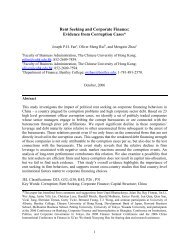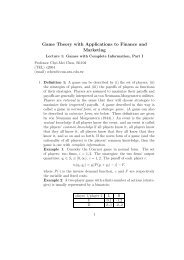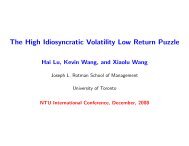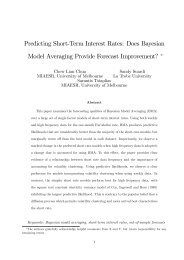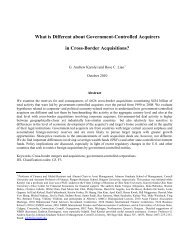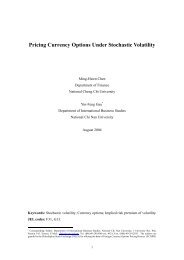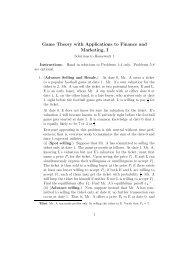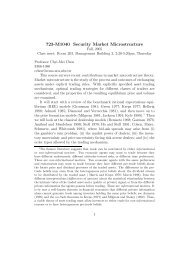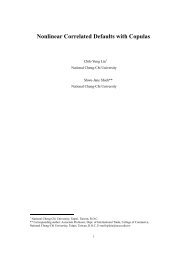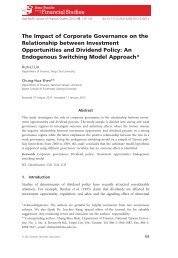Game Theory with Applications to Finance and Marketing
Game Theory with Applications to Finance and Marketing
Game Theory with Applications to Finance and Marketing
You also want an ePaper? Increase the reach of your titles
YUMPU automatically turns print PDFs into web optimized ePapers that Google loves.
is the necessary <strong>and</strong> sufficient condition that supports the equilibrium<br />
where Mr. A exerts a low effort.<br />
This exercise delivers the basic idea of signal-jamming. Note that if<br />
the market believes that Mr. A will exert a high effort (because it<br />
is efficient <strong>to</strong> do so from the firm’s perspective), then Mr. A has an<br />
incentive <strong>to</strong> fool the market <strong>and</strong> raise his own payoff by exerting a low<br />
effort. By definition, a Nash equilibrium is a state of decision-making<br />
by all players, where nobody predicts his rivals’ actions incorrectly.<br />
Hence in equilibrium, Mr. A cannot have a chance <strong>to</strong> fool the market,<br />
<strong>and</strong> we have shown that this implies a corporate inefficiency in the<br />
current exercise—only exerting a low effort is consistent <strong>with</strong> a Nash<br />
equilibrium of the current game.<br />
29. Example 10. Consider a firm run by an owner-manager Mr. A. The<br />
firm has 1 share of common s<strong>to</strong>ck outst<strong>and</strong>ing. At date 1, Mr. A can<br />
either costlessly exert a low effort (e = 0) or exert a high effort (e = 1)<br />
by incurring a (non-monetary) disutility c > 0. Mr. A’s effort choice<br />
is unobservable <strong>to</strong> public inves<strong>to</strong>rs. Let π 1 <strong>and</strong> π 2 be respectively the<br />
firm’s date-1 <strong>and</strong> date-2 profits. If Mr. A exerts a high effort, the firm’s<br />
date-1 <strong>and</strong> date-2 profits are both 2. If Mr. A exerts a low effort, then<br />
the firm’s date-1-date-2 profits may be<br />
(π 1 , π 2 ) =<br />
{<br />
(0, 1), <strong>with</strong> probability β;<br />
(2, 6), <strong>with</strong> probability 1 − β.<br />
The firm has no growth opportunities after date 2, <strong>and</strong> it will be liquidated<br />
at the end of date 2. Mr. A <strong>and</strong> all inves<strong>to</strong>rs in the financial<br />
market are risk-neutral <strong>with</strong>out time preferences.<br />
Now suppose that the firm has decided not <strong>to</strong> distribute cash dividends<br />
at date 1, <strong>and</strong> that<br />
β = 5 7 , c = 2.<br />
(i) Suppose that it is common knowledge that Mr. A will never sell<br />
shares by the end of date 2. What is the date-1 share price of the firm?<br />
(ii) Suppose that, contrary <strong>to</strong> part (i), it is common knowledge that<br />
Mr. A will sell all the equity at date 1, <strong>and</strong> that public inves<strong>to</strong>rs’ only<br />
date-1 information about the firm is π 1 . What is the date-1 share price<br />
35



